Scindapsus is one of the most common home-grown vines. This plant fell in love with flower growers for its unpretentiousness, rapid growth, and a wide variety of colors of decorative leathery leaves.
According to the botanical classification, only the painted and Siamese variety with silvery spots on the leaves belongs to the genus Scindapsus, all other species have recently been reckoned to the genus Epipremnum, although in everyday life they are all known as scindapsus. Caring for scindapsus at home is the same for all these vines, so we will not divide them by genus and consider all popular species and varieties with photos, as well as the rules for their maintenance.

SCINDAPSUS IN NATURAL AND INDOOR CONDITIONS
Scindapsus are representatives of the Aroid family, their homeland was originally the humid tropics of Southeast Asia and Northern Australia. But gradually these plants naturally expanded their range, now they also grow in the rainforests of America. Scindapsus growing in natural conditions bear little resemblance to the potted plants we are accustomed to. These are powerful vines with huge leaves and thick stems reaching over 40 m in length. They twine around tree trunks, using them as a support, and grow upward, striving from the darkness of the rainforest to sunlight.
The leaves of one of the most common types of scindapsus pinnate grow up to 90 cm in length, and the dissected leaf plates of Epipremnum giganteum reach 1.2 m.
Of course, it is impossible to keep such giants at home, but it would be a mistake to think that some dwarf species of scindapsus are grown in the rooms. No, these are ordinary natural species, just when kept indoors, scindapsus do not realize the potential inherent in them by nature, they remain in childhood. Therefore, at home it is impossible to see how the scindapsus blooms . Remaining “children”, these vines never bloom at home, their leaves remain juvenile and the length of the shoots does not exceed 5 m. But if such a “baby” is planted in the jungle, it will grow into a full-fledged adult vine with large leaves. The inflorescence of this plant, like that of other Aroids, is an ear wrapped in a blanket.
Scindapsus is appreciated for its simple home care, especially for the most common type – golden scindapsus. This vine is very unpretentious and shade-tolerant, rarely affected by diseases and pests, it can grow away from windows, quickly gaining green mass. Having planted several cuttings in pots, in six months you can get highly decorative specimens that will become a real decoration of the interior.
BENEFITS OF SCINDAPSUS
Together with monsters and hoyi, scindapsus are subject to the slander of superstitious people, attributing to them some mystical properties. Meanwhile, back in 1989, their indisputable benefits were proven to improve the microclimate and air composition in residential premises. NASA scientists have studied several dozen species of indoor plants in order to determine the most effective of them for air purification on working orbiting space stations. The main household air pollutants emitted by finishing materials and household items are:
- benzene;
- formaldehyde;
- trichlorethylene.
Some of the tested plants were not able to absorb these substances, others, for example, chlorophytum crested, showed activity in the absorption of formaldehyde. Scindapsus, on the other hand, surpassed chlorophytum and many other plants in its cleansing qualities, filtering the air not only from formaldehyde, but also from benzene.
The increased concentration of these harmful substances in houses and apartments is a real scourge of our time. They are distinguished by plastic, floor coverings, furniture made of chipboard and MDF, all kinds of paints and varnishes. Needless to say, how dangerous it is for health, especially for a growing child’s body. As scientists have established, for the complete cleaning of room air from benzene and formaldehyde, one copy of a medium-sized Scindapsus is enough for every 9 square meters. m of living space.
So Scindapsus not only delight us with their beauty but also bring undeniable benefits to our health. It should only be remembered that their juice is poisonous, like many plants of the Aroid family. You can protect yourself from its toxic effects by being careful when pruning and propagating the plant. It is necessary to ensure that the sap of the plant does not get on the mucous membranes and wash your hands after taking care of the Scindapsus at home, such as cuttings, transplantation. You also need to make sure that the plant is inaccessible to small children and pets.
8 Scindapsus Varieties For Indoor
At home, both natural species of Scindapsus and varieties obtained as a result of selection are grown, which are distinguished by a variety of colors and the high decorativeness of the leaves. Consider the most common types of Scindapsus with photos and names.
SCINDAPSUS GOLDEN
This natural type of Scindapsus is the most common in indoor floriculture. It is loved for its unpretentiousness, good growth in low light conditions, and the beauty of variegated leaves. Bright green leaf plates up to 10 cm long have a heart-shaped shape, glossy shine, and yellow strokes, thanks to which the plant got its name. Densely leafy unbranched shoots twine around the supports, and in their absence they hang down in a beautiful cascade.
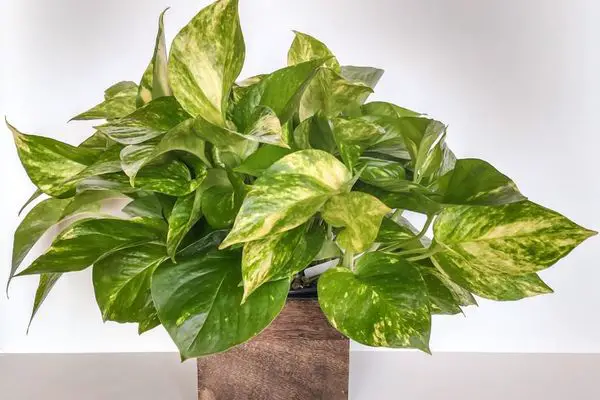
In America it is called Potos Golden. But it is golden only with sufficient lighting, in too shaded places the leaves lose their variegated color, become green. Some believe that there is a type of scindapsus with pure green leaves, but these are just specimens that have lost their “gold” due to inappropriate housing conditions and improper care of the Golden Scindapsus at home.
SCINDAPSUS MARBLE QUEEN
“Marble Queen” – this is how the name of this variety is translated. Its creamy leaves, painted with dark green strokes, really resemble marble in appearance. Due to its unusual coloring and densely leafy shoots, the Marble Queen variety has high decorative qualities. It is especially beautiful in combination with the greenery of other plants. But with a lack of light, its main advantage – marble color can disappear.
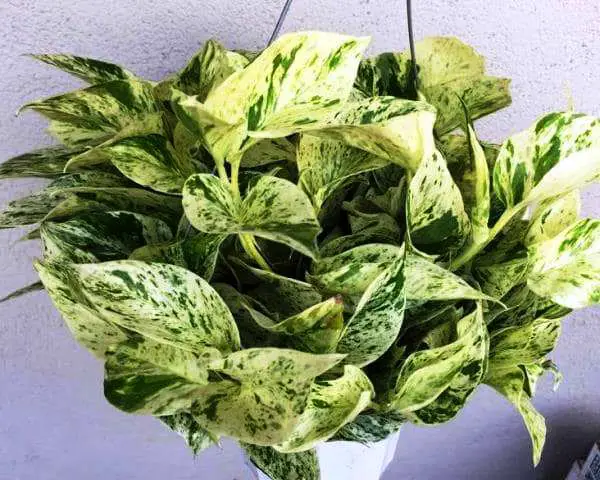
SCINDAPSUS NEON
The light green leaves of this vine resemble in their brightness the lights of neon signs, which is why the variety got its name. The brightness of the color depends on the lighting, most of all “neon” will be on the leaves of plants located near the eastern and western windows, and in shaded areas the shoots turn pale. Scindapsus Neon is especially beautiful in the “company” with a golden variety.
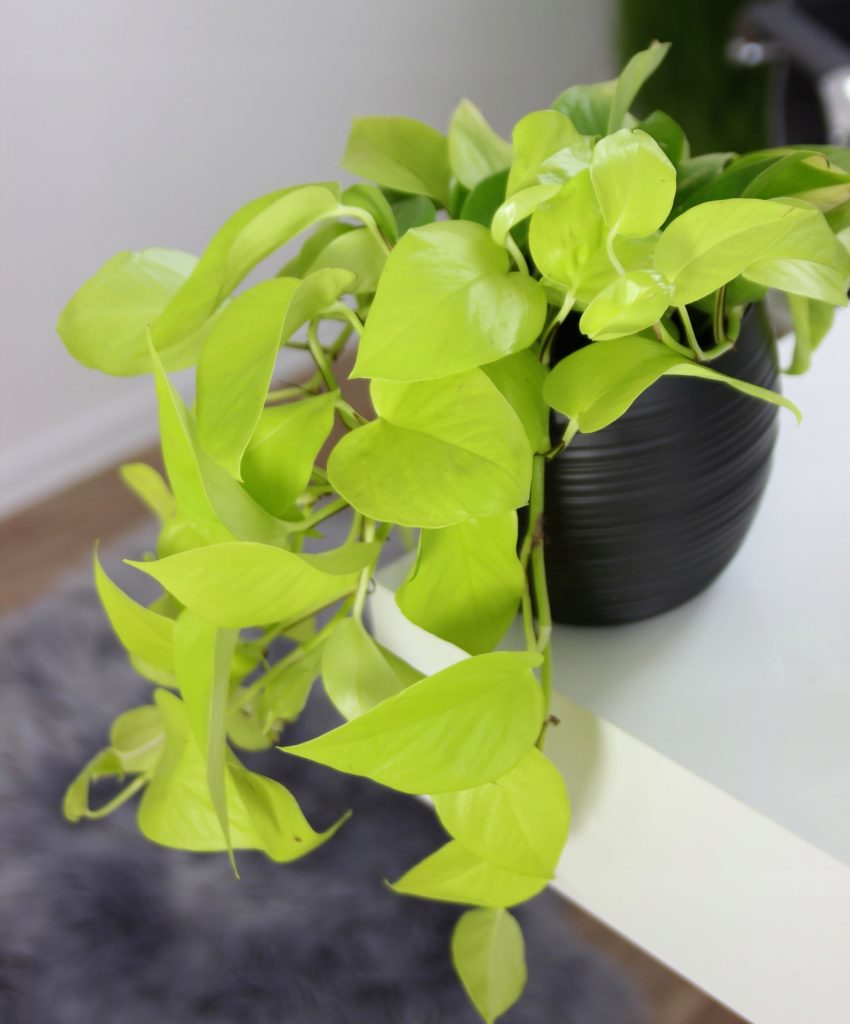
SCINDAPSUS ANGE

A distinctive feature of this variety are small leaves, decorated with large white spots. Unlike other scindapsus, the surface of the leaf plate is not smooth, it has irregularities. This contrasting variety works well with the green foliage of other plants. However, planting it in the same pot with other types of scindapsus is not recommended, since Angeloy grows slowly and rapidly growing vines will oppress him.
SCINDAPSUS PICTUS
All vines classified by botanists as belonging to the genus Scindapsus have matte dark green leaves with a bluish tint, decorated with silvery spots. Different species differ in the size of the leaves and the different nature of the silvery spots. They can be small and scattered, or they can merge and almost completely cover the surface of the leaf.
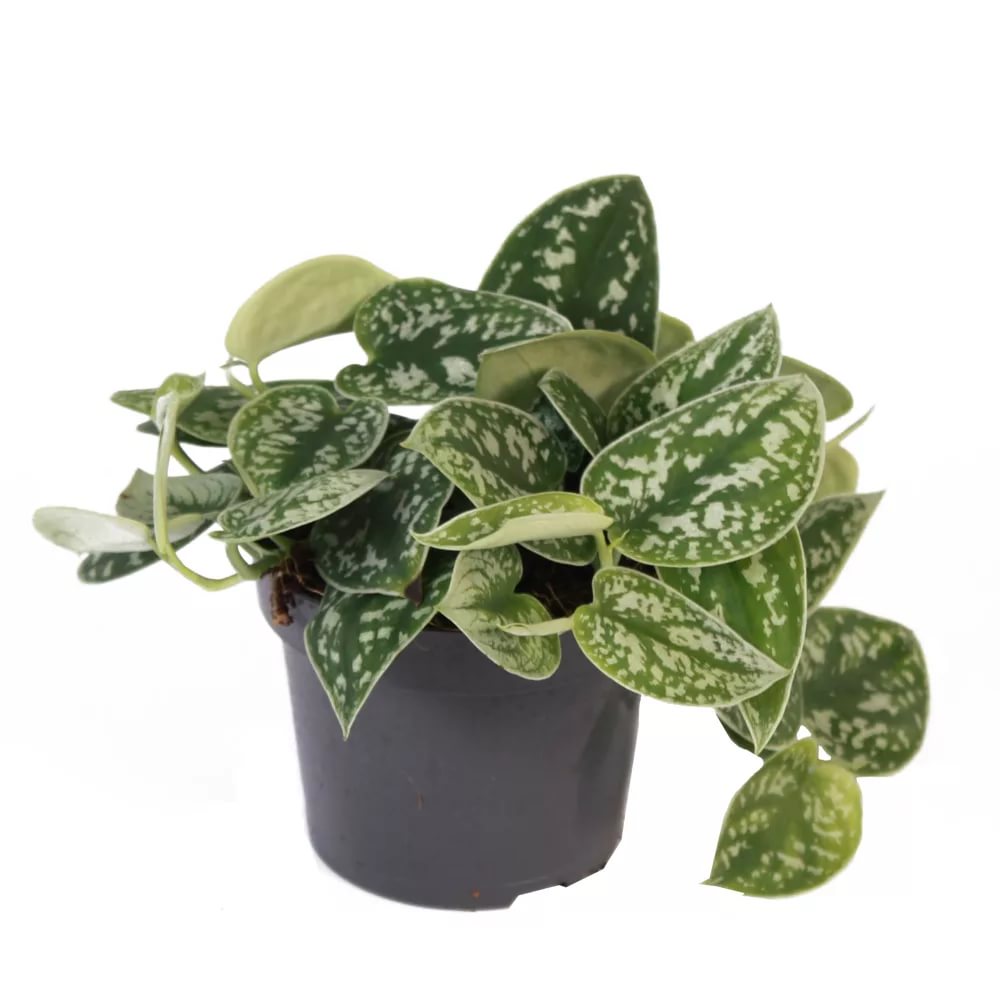
Scindapsus Painted or Pictus has small leaf plates – 7-8 cm, with a silver border along the edge. Small silvery specks are scattered all over the leaf. This species is slowly growing.
SCINDAPSUS SIAMENSIS
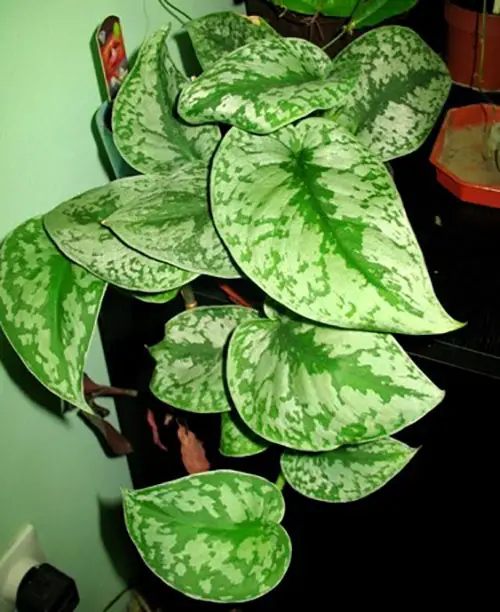
The Siamese Scindapsus has an average leaf size of 12 cm. The matte bluish-green leaf blade is not symmetrical, the central vein divides it into unequal parts. On both sides of it there are silvery spots that merge with each other. Like the painted one, this species is also distinguished by its slow growth.
SCINDAPSUS TREBIE (SCINDAPSUS TREBIE)
This is a variety of Siamese Scindapsus, differing in the location of the spots. They do not merge together, but simply thicken on both sides of the central vein.
SCINDAPSUS EXOTICA
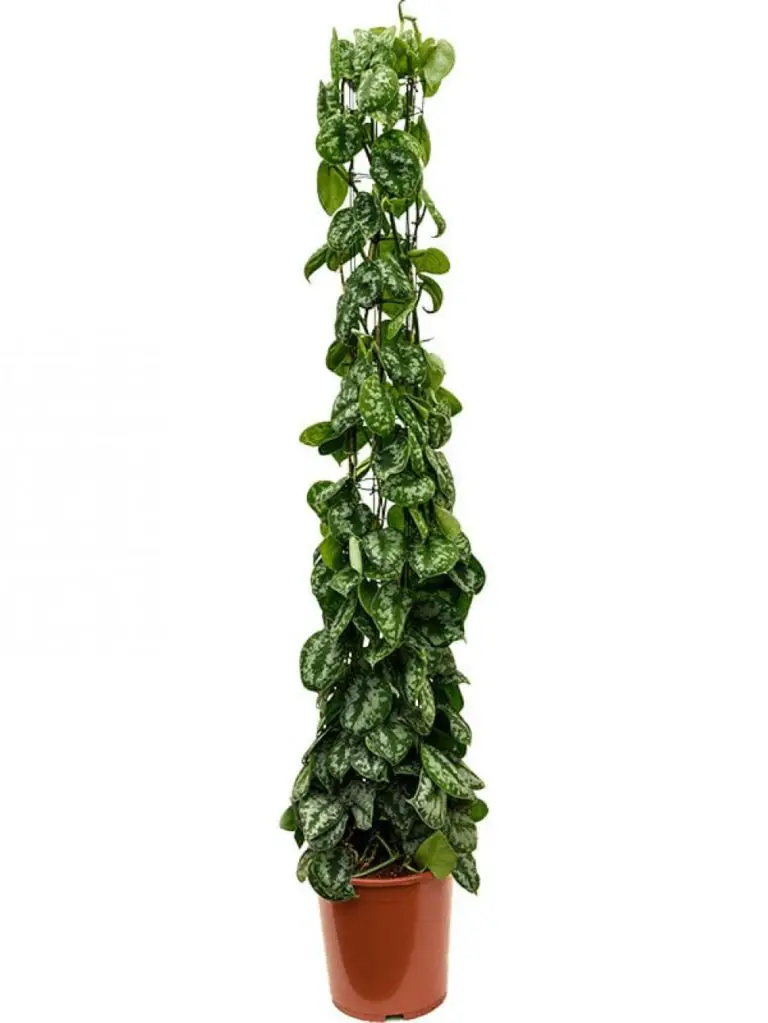
This variety has large (up to 12 cm) leaves, almost completely covered with a silvery bloom. Only along the central vein and the edges of the leaf plate, a bluish-green background is visible in narrow stripes. Scindapsus Exotic is valued for its spectacular, shiny, as if metallic, leaves. In care, this variety is more finicky than natural species.
SCINDAPSUS CARE
Almost all types of scindapsus do not require complex care; even novice indoor plant lovers can grow them. But if you want to get highly decorative specimens that will become a real interior decoration, you need to follow the basic rules for caring for scindapsus at home, which this section is devoted to.
LIGHTING
In the natural conditions of tropical forests, these vines practically do not see direct sunlight, being in the shade of tree crowns. Consequently, they do not like too bright lighting, from the intense summer sun, their luscious foliage burns out and turns pale, burn spots may appear on it. However, the lack of lighting also reduces their decorative effect – in variegated varieties, the brightness of color disappears, internodes and petioles are stretched.
The best option would be to place flowerpots on the windowsills of northern windows or near windows of east or west orientation, where they will be illuminated by diffused light and dim rays of the rising or setting sun. In southern rooms, they should be hidden in the shade, especially during the summer months. Scindapsus grow well under artificial lighting.
TEMPERATURE
All types of scindapsus are thermophilic, they do not tolerate temperatures below + 15 ° C. Do not expose them to cold drafts, sudden temperature changes. In the cold season, you need to make sure that the flowerpots do not stand on cold floors and window sills; it is necessary to put sheets of foam or other insulation under them. Overcooling of the roots can lead to their rotting and death of the plant.
These tropical lianas tolerate heat normally if you do not forget to water them in time. At temperatures from + 30 ° C and above, water and spray Scindapsus often, and they will thank you for their brightness and exuberant growth.
HUMIDITY
These inhabitants of the tropics are accustomed to high humidity, but they feel good in the dry air of apartments. It is only important to make sure that hot air from heating radiators does not get on the plants, even the most hardy plants will not withstand such a test.
Watering should be moderate, as the top layer of the substrate dries out. Water should be taken standing, without chlorine, its temperature should be 2-3 degrees higher than room temperature.
In conditions of low temperature and short daylight hours, watering should be reduced, since during this period the plant consumes less water, and its excess in the pot can lead to root rot. Scindapsus love spraying and showering. After water procedures, they look especially impressive. Use soft water for spraying so that no indelible salt stains remain on the leaves.
SUBSTRATE COMPOSITION AND POTS
Scindapsus are not picky about the composition of the soil, they are also grown in hydroponics. For growing them at home, you can take any substrate – leafy or garden soil with baking powder, peat or coconut substrate. Any plastic or ceramic pots will do, the main thing is that there are drainage holes at the bottom and the volume is not too large. The volume of soil per cutting should be about 200 ml. To obtain lush specimens, 5-10 cuttings are planted in one flowerpot, in accordance with this amount, the volume of the pot is selected.
FERTILIZER
Scindapsus quickly gain leaf mass, so they need regular feeding. Fertilizers for them can be taken organic or mineral, in which nitrogen predominates. You can buy any fertilizer for ornamental foliage plants. For variegated specimens, the recommended dosage should be halved.
During the active growing season (March-October), feeding is done twice a month, the rest of the time – monthly. With a warm content and supplementary lighting in winter, the frequency of fertilization can be left unchanged. Also, plants accept the method of feeding well with each watering, when a quarter of the recommended dose of fertilizer is added to the irrigation water. This method should not be used only at low temperatures and short daylight hours. You can also add to the soil fertilizers with prolonged action for ornamental foliage plants.
REPRODUCTION
It is best to propagate Scindapsus in spring or summer, but at normal room temperature and artificial lighting, this can be done at any time of the year. For reproduction, the stem is cut into sections with two internodes. The resulting cuttings can be rooted in water or peat substrate. When rooting in the ground, it is better to place a glass with cuttings in a greenhouse from a transparent bag and put it closer to the light. The rudiments of air roots are located throughout the stem of these vines, so they take root easily.
To obtain decorative specimens, several cuttings are planted in a pot. If only one cutting is available, it is grown in one stem, and then the resulting plants are cut and planted together, getting lush bushes. Another method of obtaining many shoots is to pin the growing stem in several places to the ground with paper clips, spreading it in a pot in a spiral. In places of contact with the substrate, the plant will take root, and young shoots will go from each leaf.
TRANSFER
It is recommended to transplant young scindapsus every six months, and it is advisable to transplant adult specimens every spring. When transplanting, the diameter of the pot should be taken 4-5 cm larger than that of the old one. With a loss of decorativeness, exposing the stems, it is better to rejuvenate the plant by blackening young shoots.
While the plant is small, it can be grown as ampelous, but in general, like all vines, Scindapsus prefer to curl along supports. To do this, you can stick a special grate or a stick wrapped in coconut fiber into the pot. You can also stretch the ropes along which the stems will curl, creating a special comfort and exotic atmosphere in the apartment.
PEST AND DISEASE CONTROL
This liana is highly resistant to diseases, but under unfavorable conditions of detention it can be affected by a scabbard, a spider mite. The systemic insecticide “Aktara” has good effectiveness against insects, and the spider mite can be defeated by applying several treatments with the acaricides “Sunmight”, “Oberon”, “Nissoran”. Due to the high adaptability of this pest, it is recommended to alternate preparations during treatments.
